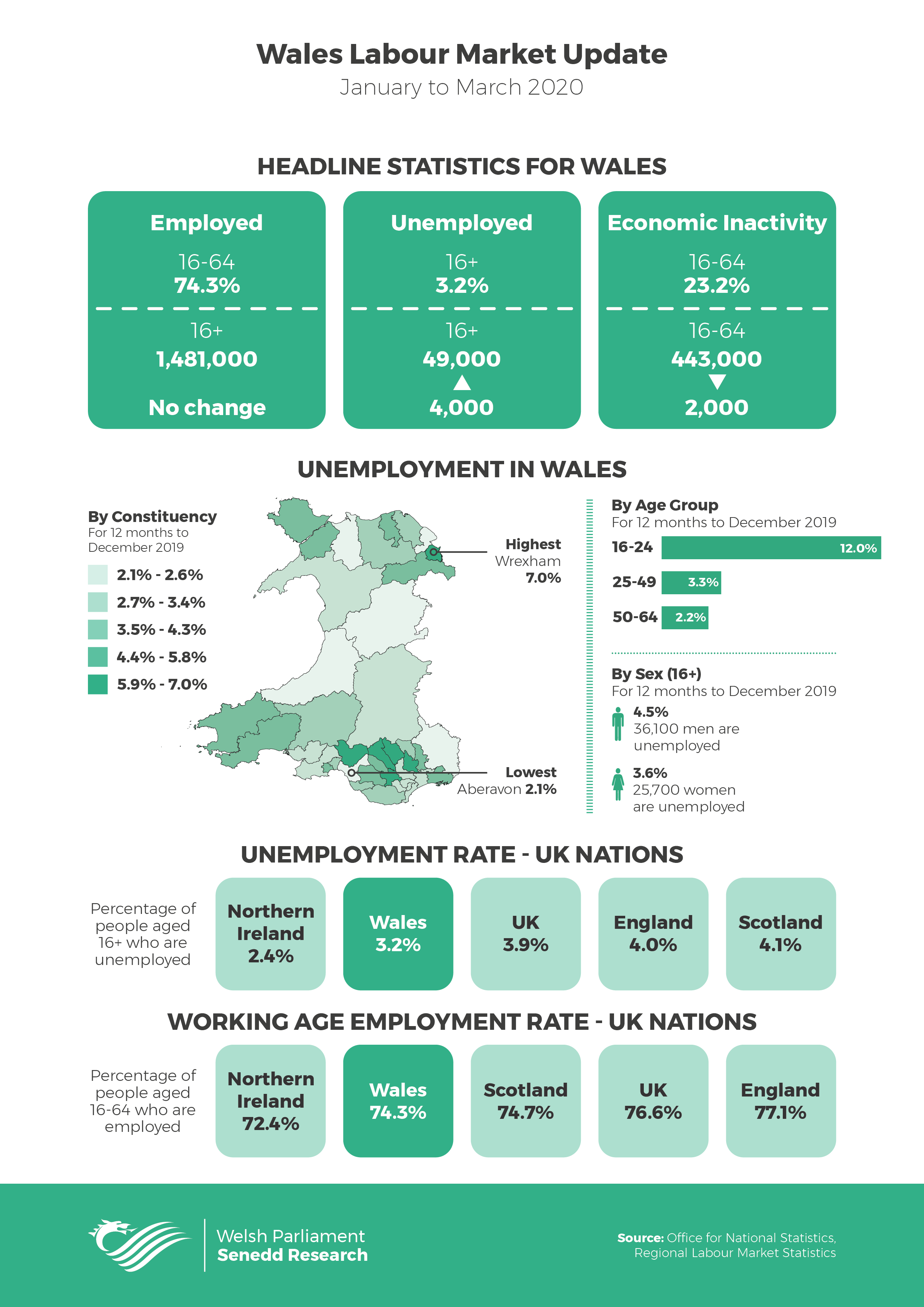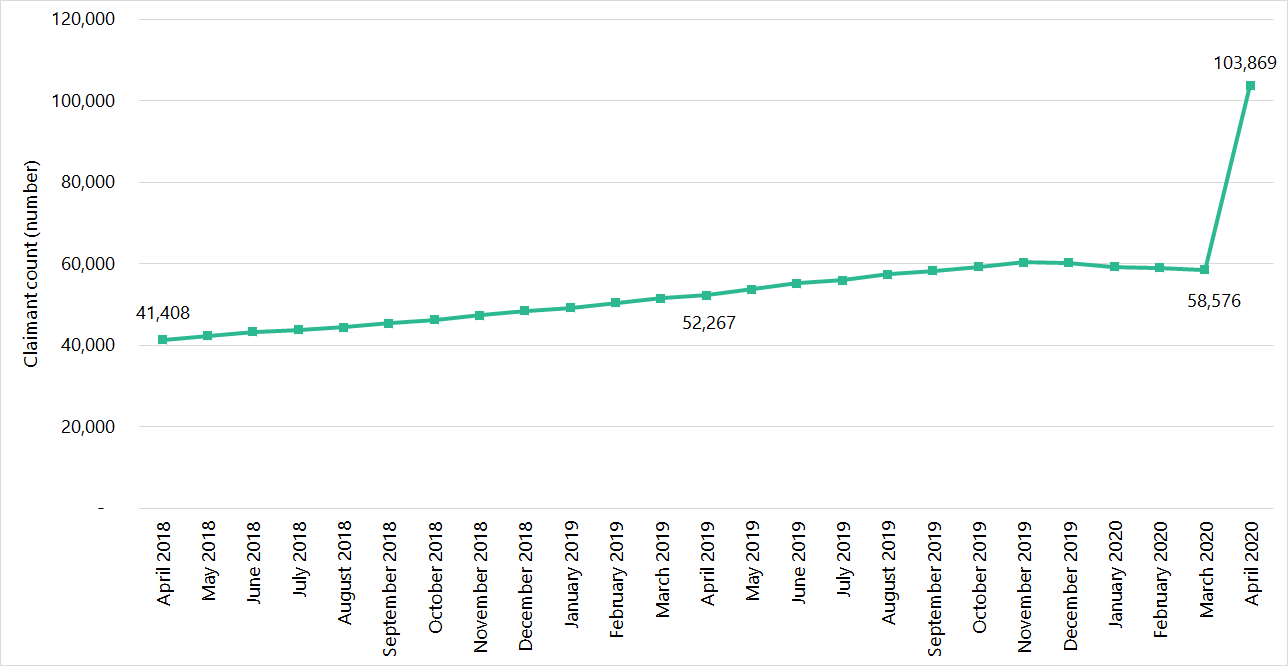This article was last updated on 1 June 2020
When will official statistics start to reflect the impact of coronavirus on the labour market?
Each month the Office for National Statistics (ONS) publishes estimates of employment and unemployment rates. These estimates are based on information collected by the Labour Force Survey (LFS) for the preceding three-month period. The time lag to these figures means that the latest labour market release published on 19 May 2020 provides information from January 2020 to March 2020. Therefore it may not be until June that the LFS will start to reflect the impact of coronavirus on the labour market.
What is the latest situation in Wales?
For January 2020 to March 2020 the unemployment rate for people aged 16+ in Wales was 3.2%, compared to 2.9% in the previous quarter (October 2019 to December 2019). This is an increase of 4,000 people from the previous quarter up to 49,000. The unemployment rate in Wales is lower than England (4.0%), UK (3.9%), Scotland (4.1%) and higher than Northern Ireland (2.4%).

Are there other data we can use to see the impact of coronavirus on the labour market in Wales?
Claimant count – seasonally adjusted
ONS publishes an experimental series counting the number of people claiming Jobseeker's Allowance plus those who claim Universal Credit and are required to seek work and be available for work. This replaces the number of people claiming Jobseeker's Allowance as the headline indicator of the number of people claiming benefits principally for the reason of being unemployed. The latest data for April 2020 shows that the Wales claimant count went up by 45,293 to 103,869.
Claimant count for Wales; April 2018 to April 2020
 Source, NOMIS, ONS Claimant Count – seasonally adjusted
Source, NOMIS, ONS Claimant Count – seasonally adjusted
Notes: From May 2013 onwards these figures are considered Experimental Statistics. Under Universal Credit a broader span of claimants are required to look for work than under Jobseeker's Allowance. As Universal Credit Full Service is rolled out in particular areas, the number of people recorded as being on the Claimant Count is therefore likely to rise. Rates for regions and countries from 2018 onwards are calculated using the mid-2018 resident population aged 16-64.
Number of Universal Credit Claims
The Secretary of State for Work and Pensions, Therese Coffey MP responded to a letter from the Chair of the Welsh Affairs Committee, Stephen Crabb MP on 21 May 2020. The letter details the number of individuals and households claiming Universal Credit between 1 March 2020 and 12 May 2020. The number of individual claims for Universal Credit in Wales totalled over 122,000 in this period, peaking at 6,860 on 27 March 2020.
Number of Universal Credit claims in Wales; 1 March 2020 to 12 May 2020
 Source: UK Parliament, Welsh Affairs Committee, Universal Credit claims up 120,000 in Wales since coronavirus outbreak 22 May 2020
Source: UK Parliament, Welsh Affairs Committee, Universal Credit claims up 120,000 in Wales since coronavirus outbreak 22 May 2020
ONS Business Impact of COVID-19 Survey
ONS has started a new online survey Business Impact of COVID-19 Survey which surveys around 17,600 businesses in the UK on a fortnightly basis. This survey asks questions on employment, turnover, business expectations and government support. The latest set of results were published on 21 May 2020 for the period 20 April to 3 May 2020. A total of 6,196 businesses responded to the survey in the UK with 652 businesses with a presence in Wales responding. ONS states:
Estimates from the Business Impact of Coronavirus (COVID-19) Survey (BICS) are currently unweighted and should be treated with caution when used to evaluate the impact of COVID-19 across the UK economy. Each business was assigned the same weight regardless of turnover, size or industry, and the data in the latest period are final.
When asked, ‘What is the current trading status of your enterprise?’, 79.3% of Welsh businesses that responded to the survey stated they were continuing to trade compared to 80.5% in England. A further 20.7% of Welsh businesses responded that they had temporarily closed or temporarily paused.
Percentage of all responding businesses, broken down by country, UK, 20 April to 3 May 2020. What is the current trading status of your enterprise?
 Source: ONS, Business Impact of COVID-19 Survey, 21 May 2020
Source: ONS, Business Impact of COVID-19 Survey, 21 May 2020
Notes: These data relate to the period 20 April 2020 to 3 May 2020. Final results, Wave 4 of ONS Business Impact of Coronavirus (COVID-19) Survey. (n = 6,196).
Results from this survey show that 79.8% of businesses that responded from Wales had applied for the Coronavirus Job Retention Scheme, 69.3% had deferred VAT payments, 40.6% had applied for a business rates holiday and 25.5% had applied for the HMRC Time to Pay scheme. These percentages are higher than those for the other countries.
Percentage of businesses either continuing to trade or who have temporarily paused or ceased trading, broken down by country, UK, 20 April to 3 May 2020. Has your enterprise applied for any of the following initiatives?
 Source: ONS, Business Impact of COVID-19 Survey, 21 May 2020
Source: ONS, Business Impact of COVID-19 Survey, 21 May 2020
Notes: These data relate to the period 20 April 2020 to 3 May 2020. Final results, Wave 4 of ONS Business Impact of Coronavirus (COVID-19) Survey. (n = 6,196).
Article by Helen Jones, Senedd Research, Welsh Parliament
We’ve published a range of material on the coronavirus pandemic, including a post setting out the help and guidance available for people in Wales and a timeline of Welsh and UK governments’ response.
You can see all our coronavirus-related publications by clicking here. All are updated regularly.






